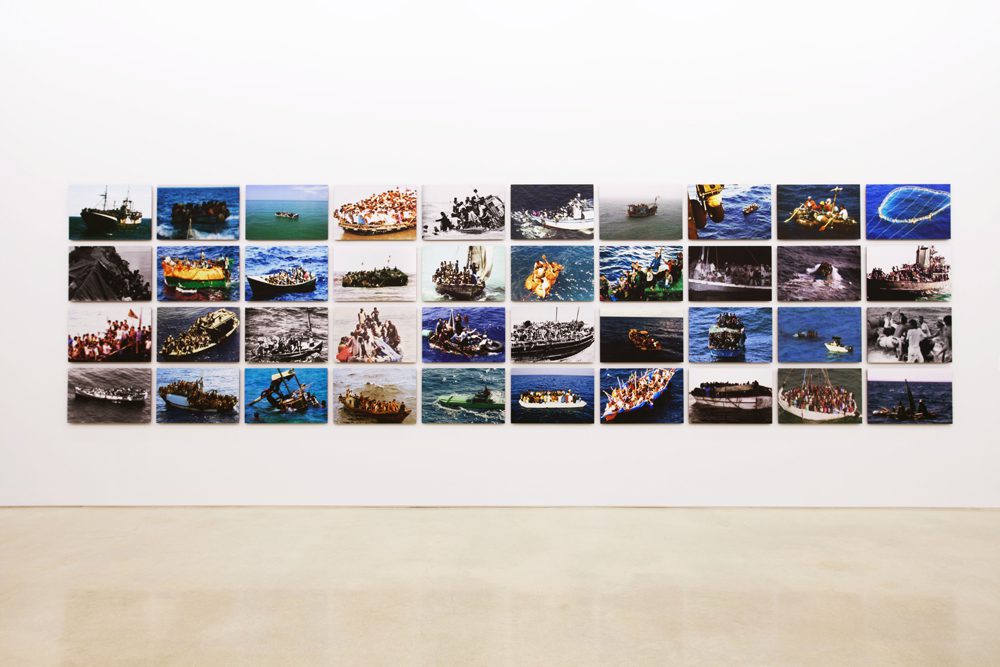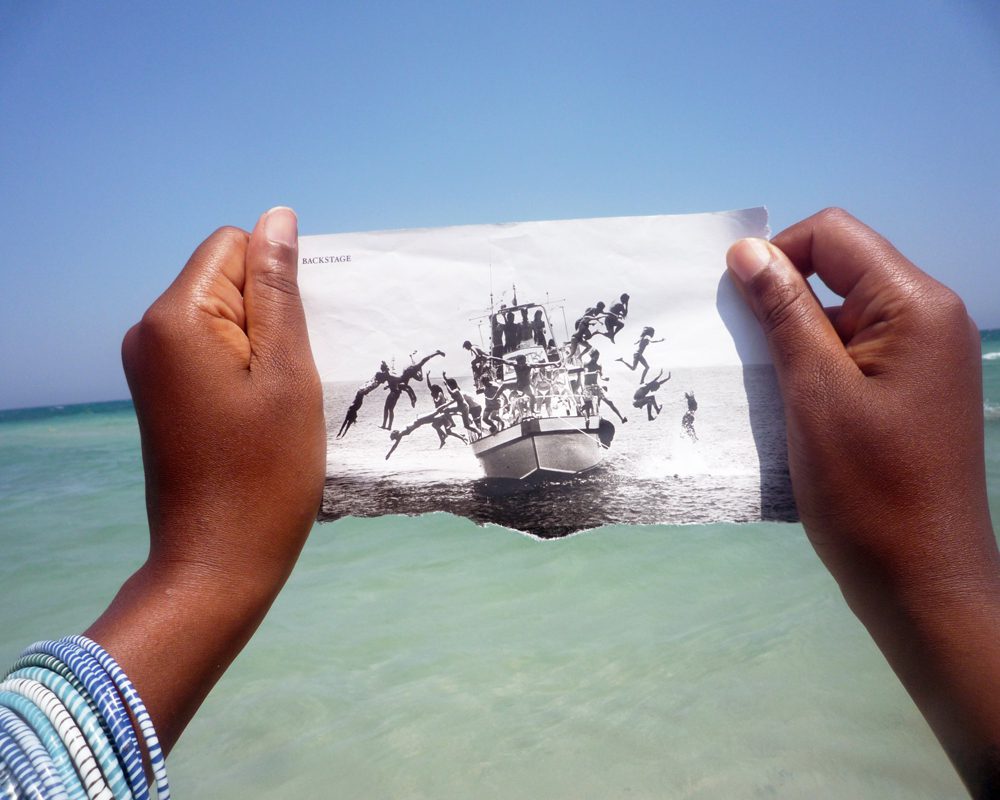Future Landscapes: Syncopation in the Work of Xaviera Simmons
Allison Glenn looks at two works by artist Xaviera Simmons that challenge our conceptions of history through images of forced migration across water.

Xaviera Simmons, Superunknown (Alive in The), 2010. 40 color photographs. Courtesy the artist and David Castillo Gallery, Miami.
Syncopation involves a rhythm that disturbs our perception of time as a regular flow, producing the feeling that time may be coming out of joint.
Anri Sala, “Muse: Syncopation”
Xaviera Simmons’ Superunknown (Alive in The), 2010, is a grid of harrowing photographs of migrants traveling in nautical vessels on water. Many of the images are grainy and pixelated. The seductively lush, blue-green waters that encompass these vessels of varying sizes belie the plight of the travelers. And this tension, inherent in each photograph, points to the urgency of the migrants’ journeys. An image of a capsized ship with people hurriedly collecting belongings that have gone overboard is included alongside one of a man coaxing his companion to jump from one small, haphazard boat to another. Time is a shifting theme here—difficult to grasp and dangerous to lose—but the desire for future landscapes is clear.
The 40 found photographs that appear in Superunknown are sourced from the mass media and websites such as that of Human Rights Watch. With the accumulation and re-presentation of photographs taken from many sources, Simmons both mines and fractures the idea of a linear archive. This reconfiguration of history is a common thread in the artist’s practice. Working across multiple media, including photography, sculpture, installation, performance, and sound, Xaviera Simmons often disrupts our understanding of memory, time, and the landscape. Curator Jill Dawsey notes, “Her characters invoke a state of being between past and future identities, of being outside the established order—which is to say, a state of possibility.”
This gesture of disruption may have been cemented during a year-and-a-half-long pilgrimage that Simmons participated in when she was 21, retracing the transatlantic slave trade. Organized by a group of Buddhist monks, the journey consisted of daily, eight-hour meditative walks. The dérive began in Massachusetts, made a stop here in New Orleans, went on to Key West, and eventually arrived in Gambia. Simmons followed this with a year-long, self-directed tour of Africa with a friend.

Xaviera Simmons, On Sculpture #2, 2011. Color photograph. Courtesy the artist and David Castillo Gallery, Miami.
This formative trip laid the groundwork for the artist’s continual investigations into the intersection of the landscape, the body, and the archive. Simmons’ inaugural journey was a meditation on the artist’s approach to history, “engag[ing] with in-between spaces, with nonlinear narratives, with narratives that drop off and then continue, with shifting landscapes and shifting narratives, shifting characters and shifting histories.” This shift is present in Simmons’ color photograph On Sculpture #2, 2011, in which the artist holds a black-and-white image of people jumping and diving off a boat. The dog-eared and tattered edges of the monochromatic document show that it may have been torn from a print publication. Around the edges of the color photograph, a warm turquoise sea laps at a cool blue sky. Time here is again difficult to discern. The horizon line of the archival image is cleverly mapped onto that of the sea; the disruption happening across space and time. The artist’s reformulation of a linear narrative into one that is rhizomatic syncopates traditional, Western, linear views of history in relation to its effects on the diaspora. In music, “syncopation” describes the shift in stress from the strong beat to the weaker one. It is an interruption of the regular beat.
In “This is the Voice of Algeria,” Frantz Fanon discusses the power of these disruptions. While Fanon’s argument is tied to the colonial experience—specifically the necessity of Algerians’ awareness of the power of mass media—it provides a platform to consider Simmons’ impulse. During the Algerian Revolution, “the Algerian…had to enter the vast network of news…to find his way in a world…in which events existed, in which forces were active.” With Superunknown, Simmons is sifting through and selecting news coverage and found images in a similar fashion to experiment with the, “layering of diverse narratives and...the ways characters can be developed when you complicate a narrative of any given landscape.” And this complicated landscape cannot be more evident than in On Sculpture #2.
Earlier this year, visual artist and filmmaker Anri Sala spoke about the presence of syncopation in contemporary art: “If we imagine the beat as a wave coming toward the shore—an event that you can see ahead of its arrival—the offbeat, by contrast, is the undertow that compensates for it, the invisible wave that pulls you offshore.” The unexpected placement of Simmons’ body within the composition is Sala’s “invisible wave.” The centering of Simmons’ body within the photograph is an unexpected rupture in the dominant narrative of art history, asking the viewer to consider differing subject positions and affecting how our bodies come to understand time and their location within it.



